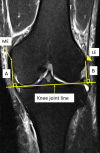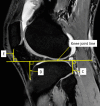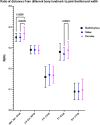Knee joint line related to bony landmarks of the knee: a radiologic study in a Thai population
- PMID: 35168654
- PMCID: PMC8845375
- DOI: 10.1186/s43019-022-00135-5
Knee joint line related to bony landmarks of the knee: a radiologic study in a Thai population
Abstract
Background: During revision total knee arthroplasty (TKA), knee joint line restoration may be difficult due to bone loss or structural changes. Although bony landmarks are consistent and can be used as references, there are limited data in Asian patients. We studied the knee joint line related to bony landmarks of the knee in a Thai population.
Materials and methods: Magnetic resonance imaging (MRI) of 140 healthy knees of Thai patients (70 males, 70 females) were investigated. In all knees, a perpendicular line from knee joint line to the medial epicondyle (distance A) and the lateral epicondyle (distance B) in the coronal plane were measured. In the sagittal plane, a perpendicular line from the knee joint line to the fibular head (distance C), the tibial tubercle (distance D), and the inferior patellar pole (distance E) were measured. The femoral transepicondylar width (FW) was measured along the transepicondylar axis. The ratios of distances A, B, C, D, and E related to FW were evaluated (epicondylar ratio).
Results: The mean and standard deviation (SD) of distances A, B, C, D, E, and FW were 27.1 ± 2.7 mm, 21.7 ± 2.5 mm, 12.6 ± 3 mm, 21.3 ± 3.6 mm, 7.6 ± 4.8 mm, and 76.7 ± 3.99, respectively. There was wide variation of measured values, with statistically significant differences between genders in distances A, B, C, and FW. The mean and SD of epicondylar ratios A/FW, B/FW, C/FW, D/FW, and E/FW were 0.35 ± 0.02, 0.29 ± 0.02, 0.16 ± 0.05, 0.28 ± 0.04, and 0.09 ± 0.04, respectively. All epicondylar ratios demonstrated less variation than all measured distances, with statistical differences between genders in the A/FW and D/FW ratios. However, the B/FW ratio had the highest consistent mean value. In addition, it had narrower SD than the rest (0.29 ± 0.02; range, 0.22-0.33).
Conclusions: In Thai knees, the measured distances from bony landmarks to the knee joint line had higher variation than the epicondylar ratio. Among all studied epicondylar ratios, the ratio between lateral epicondyle to joint line distance (distance B)/FW demonstrated the narrowest range of mean and SD values; therefore, this could be the most reliable landmark for intraoperative knee joint line verification by multiplying the FW of the patient by 0.29 to get distance B in that patient.
Keywords: Bony landmarks; Joint line restoration; Knee arthroplasty; Revision.
© 2022. The Author(s).
Conflict of interest statement
All authors declare that they have no competing interests relevant to this article.
Figures





Similar articles
-
Reliability of bony landmarks for restoration of the joint line in revision knee arthroplasty.Knee Surg Sports Traumatol Arthrosc. 2008 Mar;16(3):263-9. doi: 10.1007/s00167-007-0449-y. Epub 2007 Nov 29. Knee Surg Sports Traumatol Arthrosc. 2008. PMID: 18046537
-
An accurate method for locating the joint line during revision total knee arthroplasty: A radiologic study in the Chinese population.Knee. 2021 Mar;29:510-519. doi: 10.1016/j.knee.2021.03.003. Epub 2021 Mar 20. Knee. 2021. PMID: 33756261
-
Using anatomical landmarks to calculate the normal joint line position in Chinese people: an observational study.J Orthop Surg Res. 2018 Oct 19;13(1):261. doi: 10.1186/s13018-018-0963-2. J Orthop Surg Res. 2018. PMID: 30340645 Free PMC article.
-
Effect of medial epicondylar osteotomy on soft tissue balancing in total knee arthroplasty.Orthopedics. 2013 Nov;36(11):e1353-7. doi: 10.3928/01477447-20131021-14. Orthopedics. 2013. PMID: 24200437 Review.
-
Evolution of the term "epicondyle of the femur": Revisiting the anatomical and surgical literature.Clin Anat. 2024 Jul;37(5):571-577. doi: 10.1002/ca.24160. Epub 2024 Mar 23. Clin Anat. 2024. PMID: 38520312 Review.
Cited by
-
Guided Personalized Surgery (GPS) in Posterostabilized Total Knee Replacement: A Radiological Study.J Clin Med. 2025 Jan 10;14(2):429. doi: 10.3390/jcm14020429. J Clin Med. 2025. PMID: 39860435 Free PMC article.
-
Identification of the joint line in revision total knee arthroplasty using a multiple linear regression model: a cadaveric study.Arch Orthop Trauma Surg. 2023 Aug;143(8):5239-5248. doi: 10.1007/s00402-023-04792-3. Epub 2023 Mar 27. Arch Orthop Trauma Surg. 2023. PMID: 36971801
-
Prediction of Distal Femoral and Posterior Articular Surfaces in Total Knee Arthroplasty With Severe Bone Defects Using Computed Tomography-Based Templating Software.Cureus. 2024 Jun 2;16(6):e61546. doi: 10.7759/cureus.61546. eCollection 2024 Jun. Cureus. 2024. PMID: 38962584 Free PMC article.
-
Adductor tubercle as a reliable landmark for knee joint line determination: a comparative radiological study.Arch Orthop Trauma Surg. 2025 Aug 12;145(1):407. doi: 10.1007/s00402-025-06031-3. Arch Orthop Trauma Surg. 2025. PMID: 40794293
References
LinkOut - more resources
Full Text Sources

